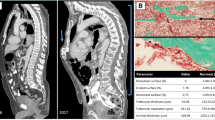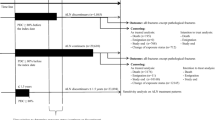Abstract
Introduction
T cell activation can lead to osteoporosis and while there are several case reports of fractures occurring after immune checkpoint inhibitor (ICI) use, to date, there are no population level studies looking at fracture risk related to ICI use.
Methods
Using Alberta Cancer Registry data, we identified all individuals treated with ICI for cancer between September 29, 2010, and March 31, 2019. Linked records from Alberta’s healthcare administrative databases were assessed for the presence of fracture diagnostic codes in the year prior to and up to two years after ICI initiation. Fracture rate was stratified based on the time-period before and after ICI initiation. Fracture rates after ICI were compared to baseline.
Results
The study cohort consisted of 1600 ICI users (mean age 65.7 years, 60% male). Most patients were treated with an anti-PD-1 agent (73.9%). ICIs were initiated on average 707.8 days after cancer diagnosis. 76 (4.8%) individuals had a remote history of a major fracture, and 141 (8.8%) had been treated with an osteoporosis medication prior to ICI treatment. The fracture rate in the year prior to ICI initiation was 11.3 per 1000 patient-years. The fracture rate in the year after ICI initiation was significantly higher at 27.3 per 1000 patient-years. The fracture rate dropped to 17.6 per 1000 patient-years in the second year after ICI initiation. The incidence rate ratio of sustaining a major fracture in the year after compared to the year prior to ICI initiation was 2.43 (95% CI 1.34–4.27).
Conclusions
Fracture risk may be increased in cancer patients early after initiation of ICI, and this may represent a novel immune-related adverse event.
Similar content being viewed by others

Data availability
All data is available upon request.
References
Haslam A, Prasad V (2019) Estimation of the percentage of US patients with cancer who are eligible for and respond to checkpoint inhibitor immunotherapy drugs. JAMA Netw Open 2:e192535
Grywalska E, Pasiarski M, Góźdź S, Roliński J (2018) Immune-checkpoint inhibitors for combating T-cell dysfunction in cancer. Onco Targets Ther 11:6505–6524
Postow MA, Sidlow R, Hellmann MD (2018) Immune-related adverse events associated with immune checkpoint blockade. N Engl J Med 378:158–168
Weitzmann MN, Cenci S, Rifas L et al (2001) T cell activation induces human osteoclast formation via receptor activator of nuclear factor kappaB ligand-dependent and -independent mechanisms. J Bone Miner Res 16:328–337
Black DM, Rosen CJ (2016) Clinical practice. Postmenopausal osteoporosis. N Engl J Med 374:254–262
Filippini DM, Gatti M, Di Martino V et al (2021) Bone fracture as a novel immune-related adverse event with immune checkpoint inhibitors: case series and large-scale pharmacovigilance analysis. Int J Cancer 149:675–683
Moseley KF, Naidoo J, Bingham CO, Carducci MA, Forde PM, Gibney GT, Lipson EJ, Shah AA, Sharfman WH, Cappelli LC (2018) Immune-related adverse events with immune checkpoint inhibitors affecting the skeleton: a seminal case series. J Immunother Cancer. 6(1):104
Statistics Canada (2019) Table 17-10-0005--01. Population estimates on July 1st, by age and sex
Cairncross ZF, Nelson G, Shack L, Metcalfe A (2020) Validation in Alberta of an administrative data algorithm to identify cancer recurrence. Curr Oncol 27:e343–e346
Alberta C (2019) The 2019 report on cancer statistics in Alberta. Alberta Health Services, Edmonton
O'Donnell S (2013) Canadian chronic disease surveillance system (CCDSS) Osteoporosis working group. Use of administrative data for national surveillance of osteoporosis and related fractures in Canada: results from a feasibility study. Arch Osteoporos 8:143
Papaioannou A, Morin S, Cheung AM et al (2010) 2010 clinical practice guidelines for the diagnosis and management of osteoporosis in Canada: summary. CMAJ 182:1864–1873
Charlson ME, Pompei P, Ales KL, MacKenzie CR (1987) A new method of classifying prognostic comorbidity in longitudinal studies: development and validation. J Chronic Dis 40:373–383
Wu CC, Chen PY, Wang SW et al (2021) Risk of fracture during androgen deprivation therapy among patients with prostate cancer: a systematic review and meta-analysis of cohort studies. Front Pharmacol 12:652979
Lee YK, Lee EG, Kim HY, Lee Y, Lee SM, Suh DC, Yoo JI, Lee S (2020) Osteoporotic fractures of the spine, hip, and other locations after adjuvant endocrine therapy with Aromatase inhibitors in breast cancer patients: a metaanalysis. J Korean Med Sci 35(46):e403
Coleman R, Hadji P, Body J-J et al (2020) Bone health in cancer: ESMO clinical practice guidelines. Ann Oncol 31:1650–1663
Camacho PM, Petak SM, Binkley N et al (2020) American Association of Clinical Endocrinologists/American College of Endocrinology clinical practice guidelines for the diagnosis and treatment of postmenopausal osteoporosis—2020 update. Endocr Pract 26:1–46
Kanis JA, Cooper C, Rizzoli R et al (2019) Executive summary of the European guidance for the diagnosis and management of osteoporosis in postmenopausal women. Calcif Tissue Int 104:235–238
Luke JJ, Ascierto PA, Carlino MS et al (2020) KEYNOTE-716: phase III study of adjuvant pembrolizumab versus placebo in resected high-risk stage II melanoma. Future Oncol 16:4429–4438
Ortega-Franco A, Calvo V, Franco F et al (2020) Integrating immune checkpoint inhibitors and targeted therapies in the treatment of early stage non-small cell lung cancer: a narrative review. Transl Lung Cancer Res 9:2656–2673
van Dam PA, Verhoeven Y, Trinh XB et al (2019) RANK/RANKL signaling inhibition may improve the effectiveness of checkpoint blockade in cancer treatment. Crit Rev Oncol Hematol 133:85–91
Acknowledgements
Data were accessed from the Enterprise Data Warehouse at Alberta Health Services via the Alberta Strategy for Patient Oriented Research (SPOR) Support Unit Data platform, a jointly funded program by Alberta Innovates and the Canadian Institutes of Health Research to support patient-oriented research.
Author information
Authors and Affiliations
Corresponding author
Ethics declarations
Ethics approval and consent to participate
The study was approved by the Health Research Ethics Board of Alberta Cancer Committee. Individual patient consent was not required due to the nature of this study.
Consent for publication
Individual consent for publication was not required due to the nature of this study.
Conflicts of interests
None.
Additional information
Publisher's note
Springer Nature remains neutral with regard to jurisdictional claims in published maps and institutional affiliations.
Rights and permissions
Springer Nature or its licensor (e.g. a society or other partner) holds exclusive rights to this article under a publishing agreement with the author(s) or other rightsholder(s); author self-archiving of the accepted manuscript version of this article is solely governed by the terms of such publishing agreement and applicable law.
About this article
Cite this article
Ye, C., Lee, K., Leslie, W.D. et al. Fracture rate increases after immune checkpoint inhibitor treatment: a potential new immune related adverse event. Osteoporos Int 34, 735–740 (2023). https://doi.org/10.1007/s00198-023-06690-1
Received:
Accepted:
Published:
Issue Date:
DOI: https://doi.org/10.1007/s00198-023-06690-1



